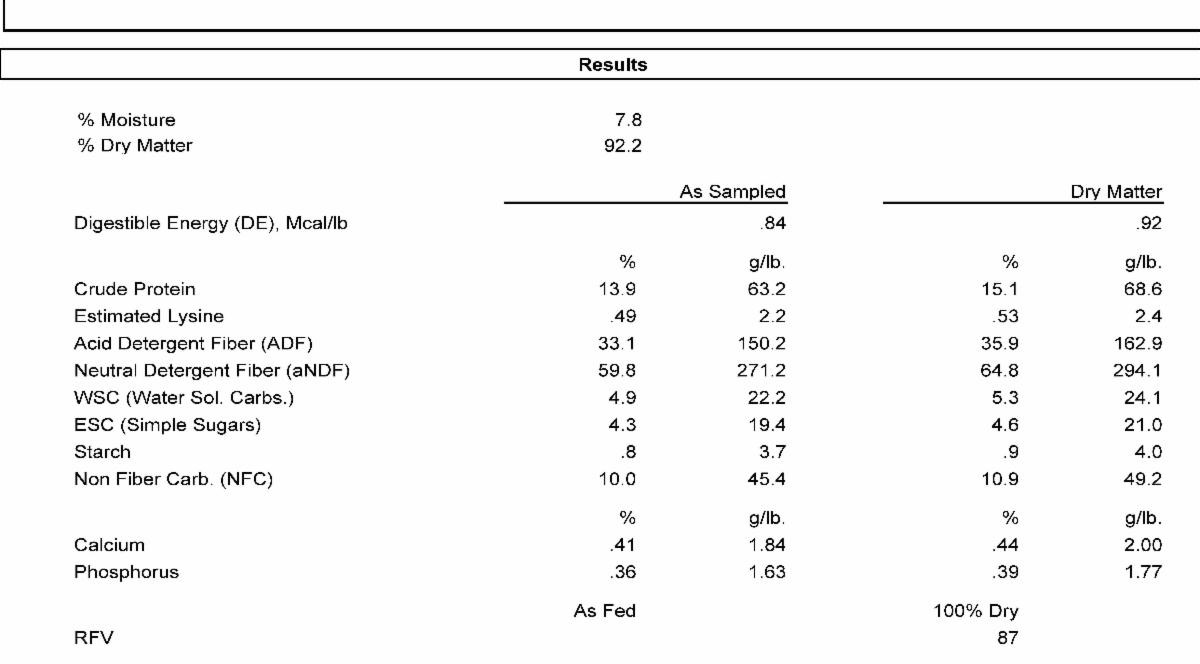Interpreting an Equine Hay Analysis

Most universities and equine nutritionists encourage horse owners to have their hay tested. However, most horse owners need help interpreting the results of their equine hay analysis. Below is a list of some of the primary components commonly analyzed for in hay, and a basic interpretation of each. Keep in mind that additional components can be analyzed for by request (and/or for an additional cost) and that each laboratory will have a unique display of results. Also, remember the equine hay analysis you receive is only as good as the sample you submit. For more information on taking a hay sample, click here.
As Sampled vs. Dry Matter Equine Hay Analysis Result
When your sample is returned, there will be two main columns of numbers; As Sampled and Dry Matter. As sampled reports nutrients in their natural state, including moisture. Dry matter reports nutrients with the moisture removed. Results reported as dry matter allow for the direct comparison of nutrients across different feeds and often simplifies the ration balancing process; therefore, we recommend owners use the percent dry matter column. In this example, this is the third column of numbers.
Moisture
The optimum moisture for horse hay ranges from 10 to 15%. Hay under 10% may be too dry, leading to brittle hay. Hays over 17% moisture have an increased risk of molding (unless propionic acid is used), and hays over 25% moisture pose the threat of severe heat damage and serve as a potential fire hazard. In the above example, the moisture of this hay is 7.8% (moisture is usually listed above the other components at the top of the report). Please note, this hay was used for a research trial, so was dried prior to analysis.
Equine Digestible Energy (DE)
DE is the measure of the digestible energy in the hay and is used to balance the energy portion of the equine diet. Most hays range from 0.76 to 0.94 Mcal/lb of DE. Different classes of horses require different amounts of DE. For example, a light working horse requires approximately 20 Mcal/day of DE. In the above example, the hay has 0.92 Mcal/lb of DE. If this hay was used to feed a horse in light work, 22 pounds of hay each day would be needed to meet the horse’s energy requirement (20 Mcal/0.92 Mcal per lb/= 22 pounds). Make sure you request an equine DE when having horse hay analyzed as sometimes the default DE calculation is for cattle.
Crude Protein (CP)
Crude protein is a measure of the protein concentration in the hay. Crude protein can range from 8 to 14% in grass hays, 14 to 17% in mixed hays, and 15 to >20% in legume hays. Hay containing approximately 12% CP is thought to meet the amino acid requirements of most adult, idle horses. Other groups of horses (e.g. lactating mares, horses in heavy work, and foals) require greater amounts of CP. If feeding hay with less than 12% CP, supplemental protein sources will likely be required. In the above example, the hay has 15.1% CP.
Acid Detergent Fiber (ADF)
ADF represents cellulose and lignin, the highly indigestible fractions of plant material. The lower the ADF value, the more digestible the nutrients in the hay are. Hays with ADF values of 30 to 35% are readily digested, while those above 45% are appropriate for feeding horses with lower energy needs (e.g. horses at maintenance). In the above example, the hay has 35.9% ADF and nutrients should be readily digested by the horse.
Neutral Detergent Fiber (NDF)
NDF is a measurement of the insoluble fiber and is classified as cell wall or structural carbohydrates. These components provide the plant with structural rigidity. The higher the NDF, the less a horse will consume; it is generally accepted as an indicator of preference. NDF levels between 40 and 50% represent hays that will be highly palatable, while those above 65% will likely not be readily consumed by most horses. However, high NDF hays can be used as “busy hays”. Both ADF and NDF can be used to help determine maturity; the higher the values, the more mature that hay tends to be. In the above example, the hay has 64.8% ADF and will likely be more slowly consumed by horses.
Non Structural Carbohydrates (NSC)
NSC is an analysis of the starches and sugars in the forage. NSC is commonly estimated by adding starch and water-soluble carbohydrates (WSC). Since some horses are very sensitive to dietary starch and sugar (e.g. horses with laminitis and metabolic syndrome), the NSC level can be helpful in selecting hay. Hays containing greater than 12% NSC should not be fed to horses diagnosed with metabolic syndromes, while NSC is rarely a concern for healthy horses. In the above example, there is 5.3% WSC and 0.9% starch for an estimated NSC of 6.2%. This example is teff hay, an annual warm-season grass becoming popular among owners managing laminitic and metabolic horses.
Calcium (Ca) and Phosphorus (P)
Ca and P are two macrominerals required in the diet by all horses in specific amounts. The levels of these minerals can vary among different types of hay. For example, legume hays have high Ca levels relative to P. For the adult, maintenance horse, the Ca:P ratio should be between 3:1 to 1:1. In the above example, the hay has 0.44% Ca and 0.39% P for a Ca:P ratio of 1.13:1. Additional minerals can be tested for if necessary.
Relative Feed Value (RFV)
RFV can be used when selecting hay but is not used in balancing equine rations. Generally speaking, higher RFV reflects higher quality, greater intake, and digestibility. An “average” hay has a RFV of 100 and most agree would be suited for horses in light work. In the above example, the RFV is 87% indicating this hay would be best suited for adult horses at maintenance.
